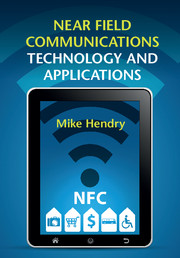Book contents
- Frontmatter
- Contents
- Part I Introduction
- Part II Technology
- 3 Standards
- 4 Modes of operation
- 5 RF requirements and components
- 6 The Secure Element
- 7 Tags and terminals
- 8 NFC apps
- 9 Infrastructure requirements
- 10 Security
- 11 Interoperability
- Part III Applications
- Part IV Implementation
- Appendix A Glossary
- Appendix B Standards
- Index
- References
7 - Tags and terminals
from Part II - Technology
Published online by Cambridge University Press: 05 December 2014
- Frontmatter
- Contents
- Part I Introduction
- Part II Technology
- 3 Standards
- 4 Modes of operation
- 5 RF requirements and components
- 6 The Secure Element
- 7 Tags and terminals
- 8 NFC apps
- 9 Infrastructure requirements
- 10 Security
- 11 Interoperability
- Part III Applications
- Part IV Implementation
- Appendix A Glossary
- Appendix B Standards
- Index
- References
Summary
Classes of NFC device
In addition to mobile phones, there are two other main classes of NFC device: tags and readers. Tablet computers, notepads and PDAs running Android, Windows 8 or another NFC-capable operating system have much the same functions as a mobile phone, but may have more memory and additional slots.
Other consumer electronics items that may be NFC-enabled include PCs, cameras, speakers, wristbands and game controllers. And a family of game controllers has also been equipped with NFC, to allow it to recognize game characters fitted with NFC tags [1]. This application requires only reader–writer mode.
Whereas NFC phones are very versatile devices that can switch between operating modes and communication types, most tags, readers and other devices are restricted to one operating mode and set of functions: an NFC interaction occurs when a phone meets one of these device types. In that case it is the phone that has to adapt and select the right form of communication.
Tags
Tags are passive devices comprising an antenna and chip. They require no battery or power source, because they draw their power from the coupled field. Tags can be standalone, small discs or square devices. They are often supplied with an adhesive surface, for sticking to working surfaces, shop windows or behind posters. Other common form factors include wristbands, keyfobs and name-badges - see Figure 7.1. Miniature tags are also available, for embedding as medical implants for example.
- Type
- Chapter
- Information
- Near Field Communications Technology and Applications , pp. 73 - 80Publisher: Cambridge University PressPrint publication year: 2014



